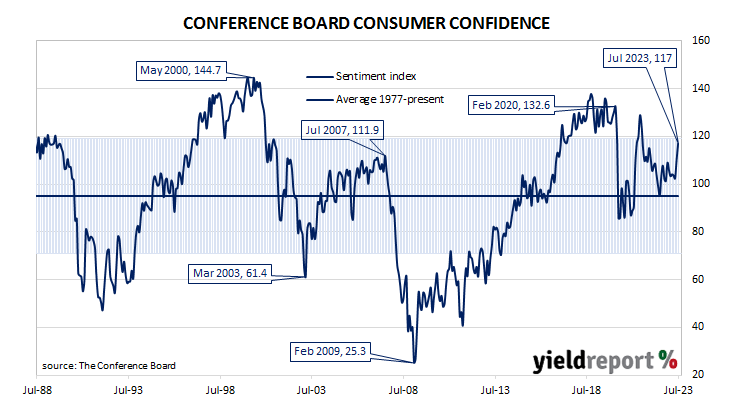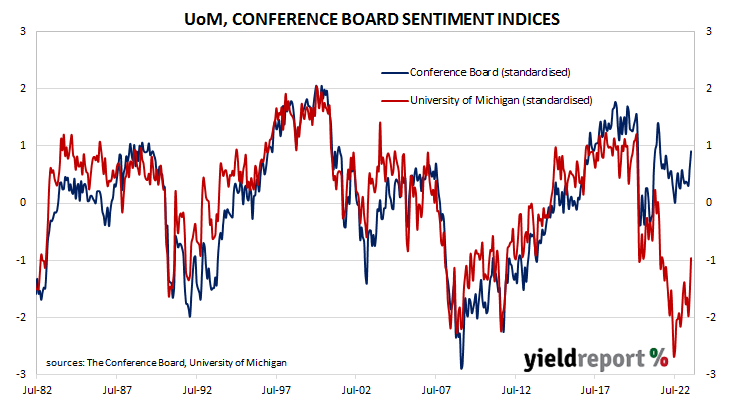Summary: Conference Board Consumer Confidence Index rises in July, reading more than expected; confidence breaks out of sideways trend; ANZ: rapid rise of interest rates has not derailed US consumer; views of present conditions, short-term outlook both improve.
US consumer confidence clawed its way back to neutral over the five years after the GFC in 2008/2009 and then went from strength to strength until late 2018. Measures of consumer confidence then oscillated within a relatively narrow band at historically high levels until they plunged in early 2020. Subsequent readings then fluctuated around the long-term average until March 2021 when they returned to elevated levels. However, a noticeable gap has since emerged between the two most-widely followed surveys.
The latest Conference Board survey held during the first three weeks of July indicated US consumer confidence has improved for a third consecutive month. July’s Consumer Confidence Index registered 117.0 on a preliminary basis, above the generally-expected figure of 112.0 as well as June’s final figure of 110.1.
“Headline confidence appears to have broken out of the sideways trend that prevailed for much of the last year,” said Dana Peterson, Chief Economist at The Conference Board. “Greater confidence was evident across all age groups, and among both consumers earning incomes less than $50,000 and those making more than $100,000.”
Shorter-term US Treasury yields moved lower on the day while longer-term yields were either steady or a little higher. By the close of business, the 2-year Treasury bond yield had lost 7bps to 4.87%, the 10-year yield had added 2bps to 3.89% while the 30-year yield finished unchanged at 3.93%.
In terms of US Fed policy, expectations of a lower federal funds rate in the first half of 2024 softened. At the close of business, contracts implied the effective federal funds rate would average 5.12% in July, 4bps more than the current spot rate, and then increase to an average of 5.325% in August. December futures contracts implied a 5.42% average effective federal funds rate while June 2024 contracts implied 4.94%, 14bps less than the current rate.
“The most rapid rise in interest rates in over four decades has not derailed the consumer and in contrast to the gloomy PMI data yesterday, suggest the main driver of economic growth is both strong and strengthening,” observed ANZ senior economist Adelaide Timbrell.
Consumers’ views of present conditions and of the near-future both improved. The Present Situation Index increased from June’s figure of 155.3 to 160.0 while the Expectations Index increased from 80.0 to 88.3.
The Consumer Confidence Survey is one of two widely followed monthly US consumer sentiment surveys which produce sentiment indices. The Conference Board’s index is based on perceptions of current business and employment conditions, as well as respondents’ expectations of conditions six months in the future. The other survey, conducted by the University of Michigan, is similar and it is used to produce an Index of Consumer Sentiment. That survey differs in that it does not ask respondents explicitly about their views of the labour market and it also includes some longer-term questions.



